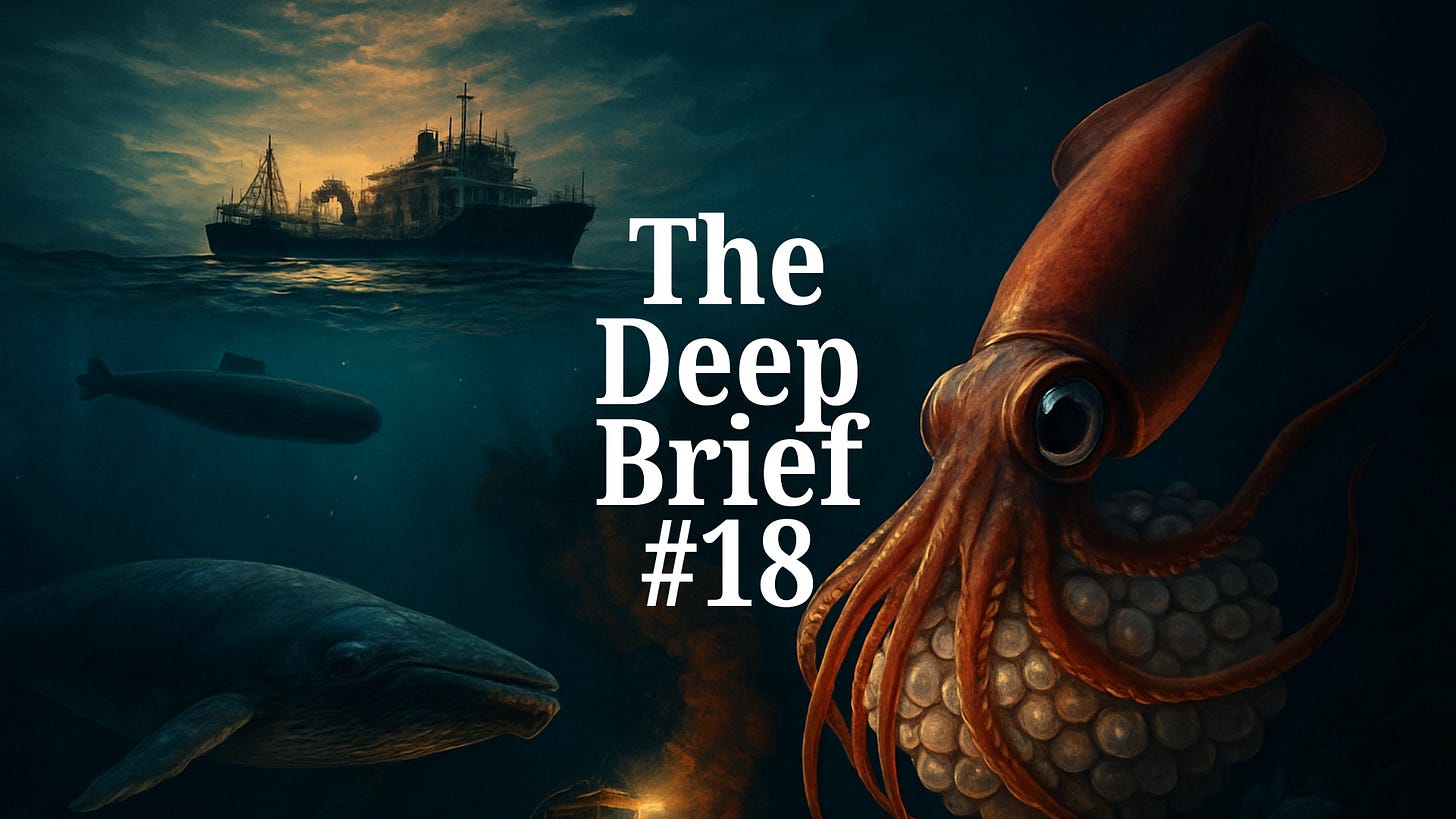The Deep Brief #18 | 8 November 2025
Your end-of-week ocean intelligence, built to inform, agitate, and equip you
This week, global ocean governance won its biggest prize yet. The High Seas Treaty took home the 2025 Earthshot Award, recognition that protecting half the planet’s surface now has international momentum behind it.
The same week, a Chinese research vessel was mapping the deep Pacific seabed. Elsewhere, new science showed that sediment plumes from mining trials don’t stay put. They rise hundreds of metres, starving ecosystems that rely on falling organic matter to survive.
This week’s Deep Brief tracks the power plays, discoveries, and warning signs shaping the ocean’s future. From breakthroughs in governance to threats rising from the deep, these are the stories that reveal how the sea is changing beneath us.
Three deep dives. Four quick hits. One hard truth from the sea.
The High Seas Treaty Wins the Earthshot Prize – Now What?
Sixty nations have ratified the treaty. Legal force arrives in two months. For the first time, the world has binding rules for the waters beyond any country’s borders: marine protected areas, environmental impact assessments, fair access to genetic resources.
The prize matters not because it validates the treaty, but because it draws attention to what comes next. Implementation. Enforcement. Turning words into boundaries that hold.
The deep sea has spent centuries beyond reach. It won’t submit to governance without funding, surveillance and political will that matches the scale of what’s at stake.
Read about the Earthshot recognition
Sediment Plumes from Deep-Sea Mining Reach Further Than Anyone Predicted
A new study has overturned one of the mining industry’s core claims: that disturbance stays local.
When machines scrape the seabed, sediment clouds rise. They don’t settle quickly. They drift, blocking the ‘marine snow’ (dead plankton, faecal matter, organic debris) that sustains life in the ocean’s twilight zone. Cut the snow supply, and you starve communities hundreds of metres above the extraction site.
The findings challenge every environmental impact assessment that assumed a contained footprint. If mining starts, the damage will spread further, last longer, and affect more species than regulators have planned for.
Climate Change Is Dimming the Arctic Ocean
The Arctic is losing more than ice. It’s losing light.
New research shows that changes in sea-ice cover, snow thickness, and water clarity are altering how much sunlight penetrates the upper ocean. The result: phytoplankton blooms are shifting in timing and location. That disrupts zooplankton, which disrupts fish, seabirds, and marine mammals.
A small reduction in underwater light is enough to destabilise an entire food web from the bottom up. The Arctic ecosystem is being rewritten by forces too subtle to photograph but too powerful to ignore.
Three Quick Hits
A new global study has exposed rampant violations in the international shark fin trade. Researchers found widespread misreporting and illegal shipments across major ports. The findings suggest that trade restrictions on threatened shark species are being routinely ignored, putting additional pressure on populations already pushed to the edge.
Read the investigation
A Chinese research vessel has been surveying the deep ocean floor in the South Pacific. The mission may appear scientific, yet seabed mapping often precedes mining exploration, cable routes, and influence-building. The data collected today could shape the geopolitics of tomorrow.
Read the report
The Commonwealth Secretariat has highlighted drones, AI, and satellite tools being used across member nations to monitor marine litter and enforce clean-up commitments. Better data means fewer excuses for inaction.
Learn more about the initiative
One Hard Truth
Ocean governance is still slower than ocean exploitation.
The High Seas Treaty winning the Earthshot Prize is genuine progress. It proves that global cooperation is possible, even now. Optimism without enforcement is decoration, however.
In the same week the treaty was celebrated, a research vessel was mapping the Pacific. Mining sediment plumes were shown to disrupt ecosystems centuries in the making. The contrast is sharp: one part of the world writes a promise, another redraws the seabed.
The problem isn’t a lack of treaties. It’s the speed at which extraction moves compared with the speed of protection. Every seabed survey conducted without oversight becomes a blueprint for mining. Every year lost to bureaucracy means more licences granted, more damage done, more ecosystems erased before they’re even catalogued.
The high seas are the last true commons. They hold 95 per cent of the planet’s living space and regulate the climate for every nation, yet they belong to none. Governance has finally arrived at the frontier, entering late, underfunded, and with enforcement tools that remain theoretical.
Beneath the legal tension is a moral one. The ocean doesn’t recognise borders, yet almost every protection framework we’ve built relies on them. The treaty’s success depends on how quickly the world can abandon the idea that the deep is a blank space waiting to be claimed.
If the High Seas Treaty fails to move from signature to surveillance, from ratification to regulation, it will become a monument to noble intent outpaced by industrial urgency. The opportunity to protect half the planet will pass into history as a gesture, not an act.
Hope exists. What matters now is whether it can be backed by funding, courage, and speed that matches the scale of what’s being lost.
If this briefing sharpened how you see the ocean, consider becoming a paid subscriber. It keeps this work independent, evidence-based, and accessible to those who can’t pay.
Why Readers Subscribe:
- Early access to podcast episodes and transcripts
- Monthly 5,000-word investigative reports
- Exclusive Q&As and behind-the-scenes dispatches
- Ad-free, independent ocean journalism
Thank you to every Founding Member and paid subscriber who makes this possible.
See you next week.
- Luke




This article arrives at such a cruical moment, building perfectly on your prior piece about the treaty's promise by now dissecting the immense operational challenges of actually protecting our high seas.